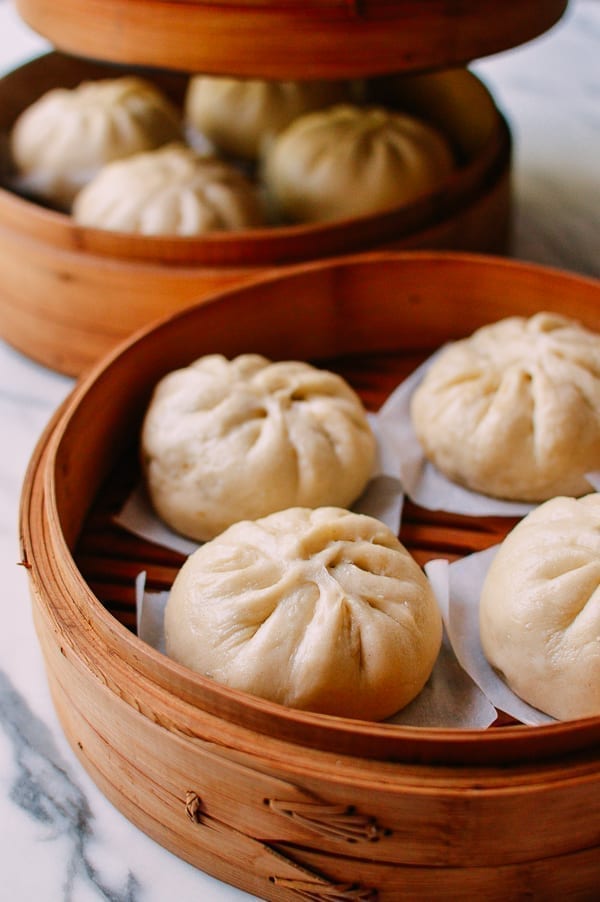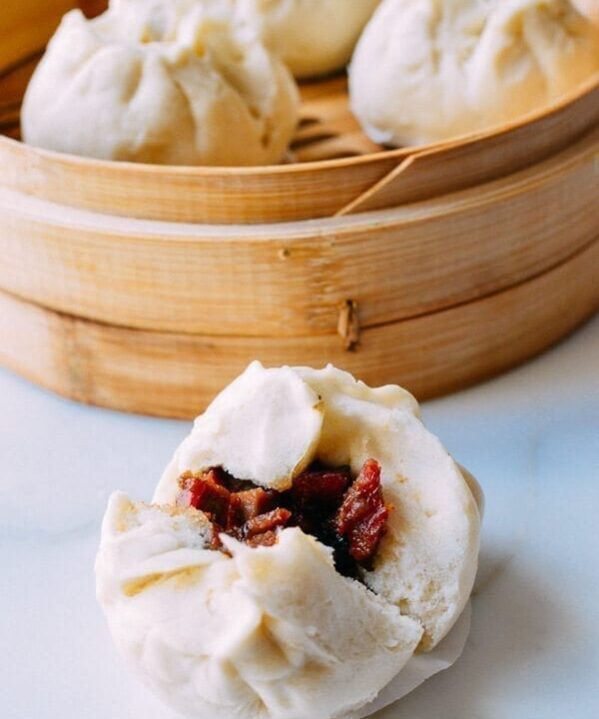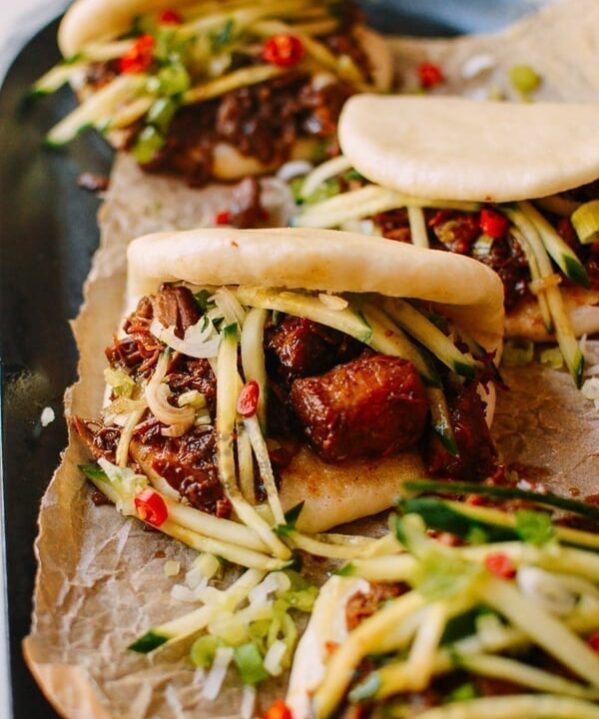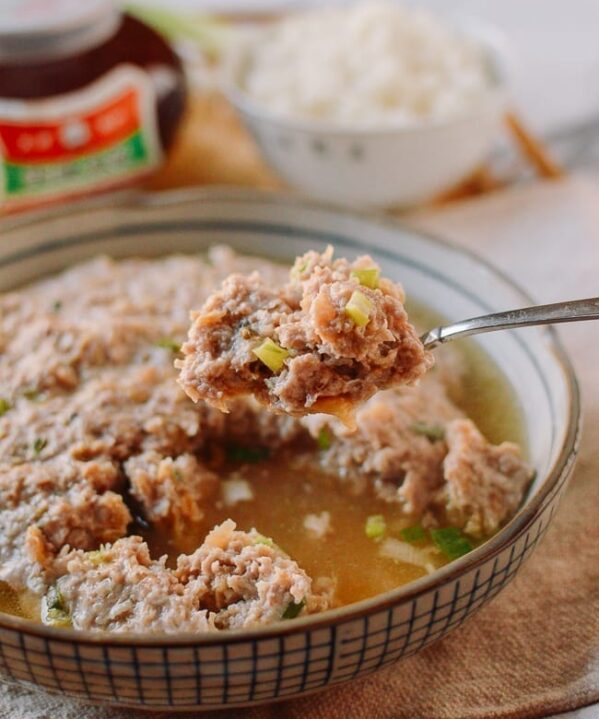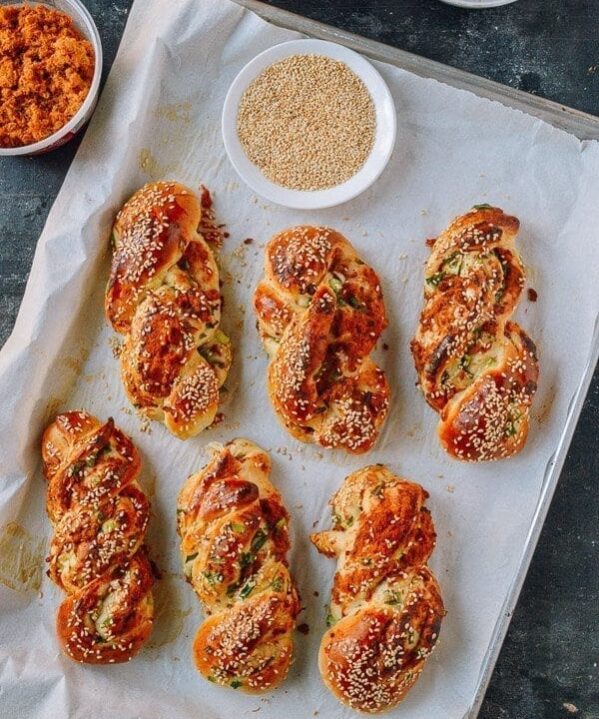Everyone has staples in their freezer––a pint of ice cream, a box of waffles, or a bag of frozen peas. The freezer staples I can’t do without are frozen rice, frozen man-tou, frozen dumplings and finally, some sort of savory bun, like these steamed pork buns (baozi, 包子 in Chinese).
They’re my emergency meal source! With these on hand, I’m never more than 30 minutes away from a satisfying meal that’s also grab-and-go. I love to make my own steamed buns, because I get to decide which delicious fillings I’m going to make.
Pleating Buns: Not Actually Required!
People tend to shy away from making steamed buns from scratch because they’re daunted by the pleating and folding step.
That does take practice, but you can also completely do away with the pleating by simply closing the top tight and turning the bun over. With the seam side down and the smooth side up, it’s a perfect looking bun without all the work!
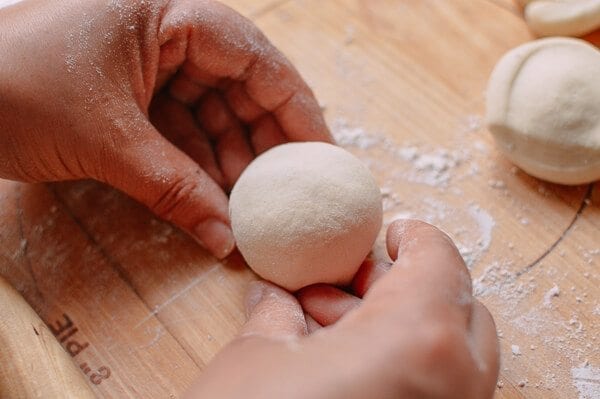
On a trivial note, I have noticed that savory buns are usually pleated, while sweet buns are turned upside down to have a smooth top like my steamed custard buns. But since no one is looking, and there really aren’t any rules here, feel free to turn your savory buns upside down and keep that trivial fact to yourself!
An Important Tip for Sealing Steamed Buns
Whether you decide to pleat or not, make sure your hands are completely dry while making the buns, and avoid getting any liquid from the filling on your hands or the outside of the dough near the point of closure. This will make it almost impossible to seal the buns.
Something to Consider: Grinding Meat for the Filling
This recipe calls for ground meat. While you could certainly buy ground pork from the grocery store, I have the secret to a superior steamed bun.
Taking the time to hand-chop the meat using just a cutting board, cleaver (or other heavy knife), and our special technique in the video below will create the ultimate texture and taste.
I know, I know, I also get lazy and sometimes buy pre-ground pork from the supermarket. But this extra 5-minute step really makes a difference to the quality of your steamed pork buns. Give it a try when you’re feeling up to it!
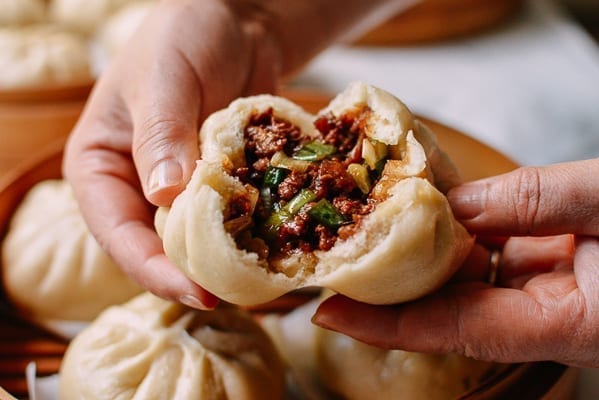
Steamed Pork Buns (Baozi): Recipe Instructions
Make the dough:
In a large mixing bowl or mixer with a dough hook attachment, completely dissolve yeast and sugar in lukewarm water. Wait 10-15 minutes to let the yeast become active and foam up.
Add in the flour ½ cup at a time and knead for about 15 minutes. Adjust the last ½ cup flour accordingly. The dough should be soft––not sticky and not too firm. Once the dough is even and smooth, form it into a ball.
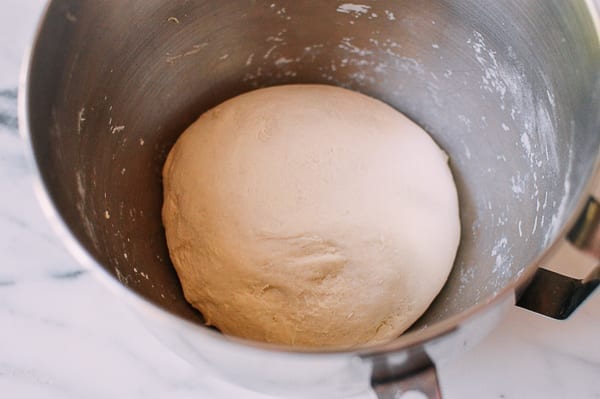
Cover it with a damp kitchen towel and let it proof one hour in a warm place. (If kneading by hand, knead the dough until it’s as smooth as a baby’s butt!)
While it’s proofing, make the filling.
Make the filling:
Add the ground meat to a large mixing bowl and stir in 3 tablespoons water until well incorporated.
Now preheat the wok or a cast iron pan until it starts to smoke lightly. Add in 3 tablespoons oil, along with the minced ginger and diced onion. Cook over medium heat until the onions soften.
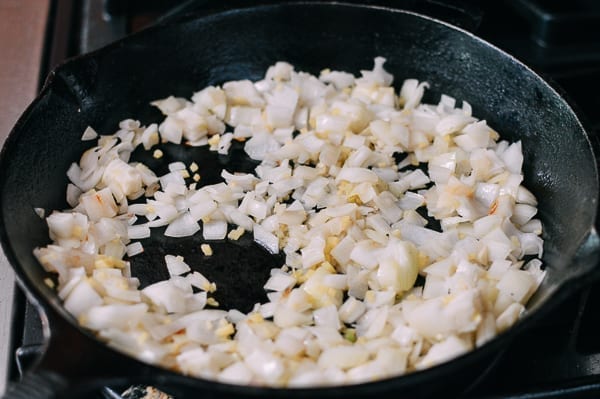
Add in the ground pork and turn up the heat, stirring to break up any large chunks. Cook until all the pork turns pale and opaque––there is no need to brown or crisp the meat.
Add wine, dark soy sauce, sweet bean sauce, ground bean sauce, oyster sauce, sugar, white pepper, and sesame oil. With the heat on high, stir everything together until well-combined. Taste the filling and adjust seasoning if needed.
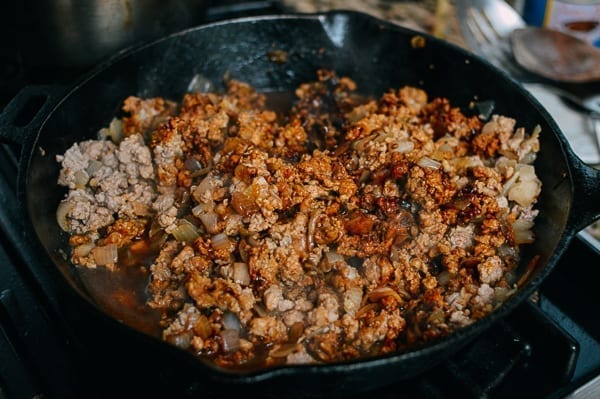
Cook for a couple of more minutes to cook off any remaining liquid. Stir in the cornstarch and water mixture, allowing everything to bubble together for 30 seconds to a minute. Turn off the heat and let the filling cool uncovered.
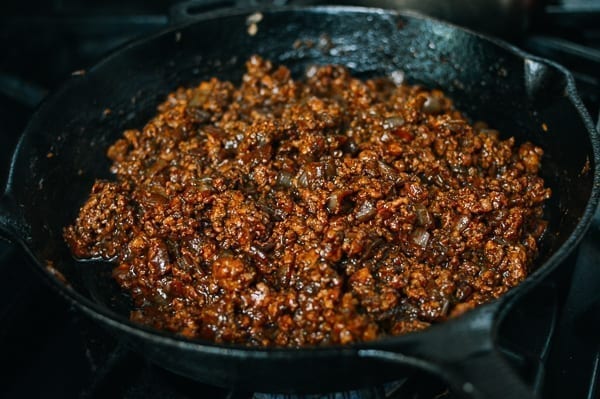
After the filling has cooled, mix in the chopped scallions.
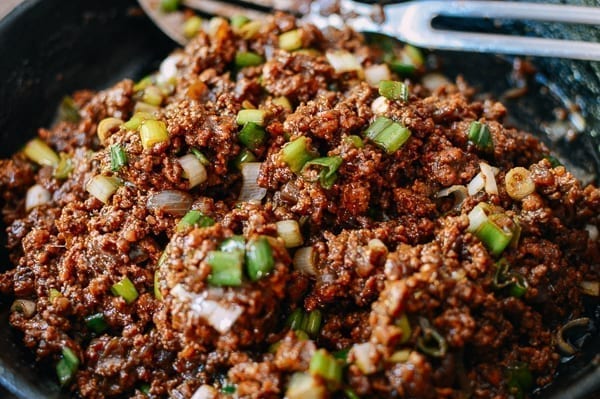
Assemble the baozi (buns):
After the dough has finished proofing, this is what it should look like:
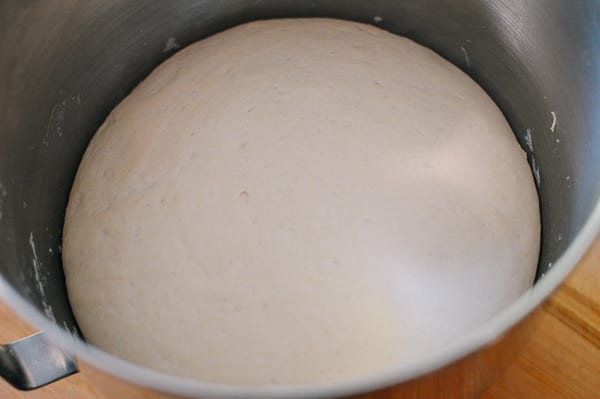
Turn it out onto a clean surface dusted with flour. Knead for 2 minutes to get rid of any air pockets.
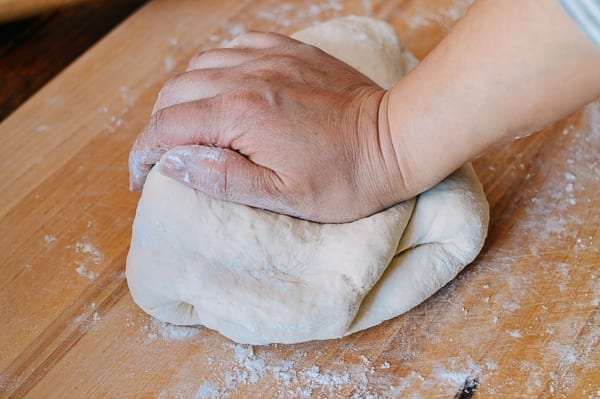
Weigh and divide the dough into 20 equal pieces (each should weigh about 48g-50g).
Take each dough ball, and with a rolling pin, roll it from the edge towards the center, without actually rolling the center of the dough. The goal is to flatten the dough into a round circle with a thinner edge and thicker center. The difference in thickness should be about 1:2. Add some filling to the center.
You can start with a smaller amount of filling until you get the hang of the folding/pleating. The buns are folded with one hand holding the skin and filling, and the other hand pleating the edges of the dough disk like an accordion. As you fold, the goal is to make it all the way around the circle, until you’ve sealed it at the top. You’ll be making about 10-15 folds.
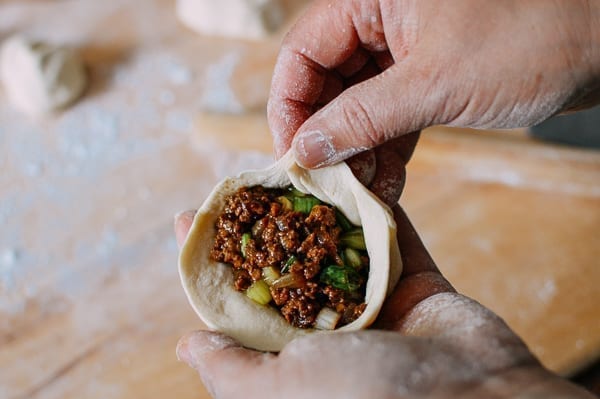
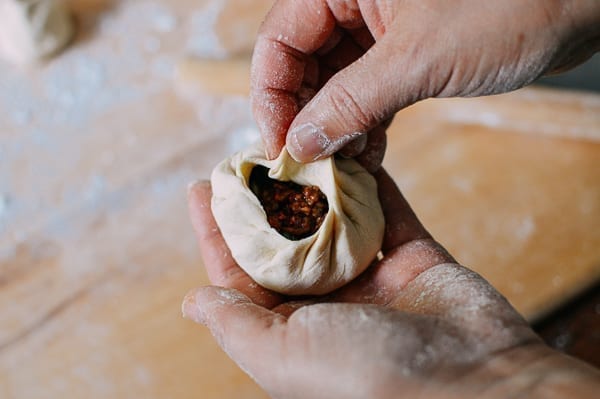
Lay the buns on a small piece of parchment paper and put it directly on your steaming rack. Repeat until all are assembled. Let the buns proof (covered) for another 15 minutes before steaming.
If you’d rather not pleat the buns at all, simply pinch the edges of dough around the filling and pinch to seal tightly. Then simply flip the buns seam side down, cover, and proof for 15 minutes.
For a more detailed demonstration of how that’s done, check out the video below:
To steam:
I used a triple level bamboo steamer. You can use whatever steaming apparatus you normally use (refer to our post on how to steam food with a bamboo steamer, metal steamer or even without special equipment).
Just remember: boiling water should never directly touch the buns during steaming. Also avoid sticking by brushing oil onto the steaming surface or adding a nonstick surface like napa cabbage leaves or parchment paper. If using a bamboo steamer, brush the sides of the steamer with oil, as the buns expand and might stick to the sides. The surface the buns sit on should be porous, not solid (like a plate). This will trap moisture and make the buns soggy. There should be some aeration going on. Finally, make sure the lid is tight so you don’t lose any steam.
With the buns in the steamer, start with cold water and turn on the heat to medium. Set the timer to 15 minutes.
After 15 minutes, turn off the heat, and keep the lid on. Let the buns “rest” for 5 minutes before opening the lid. Missing this step will cause the buns to collapse.
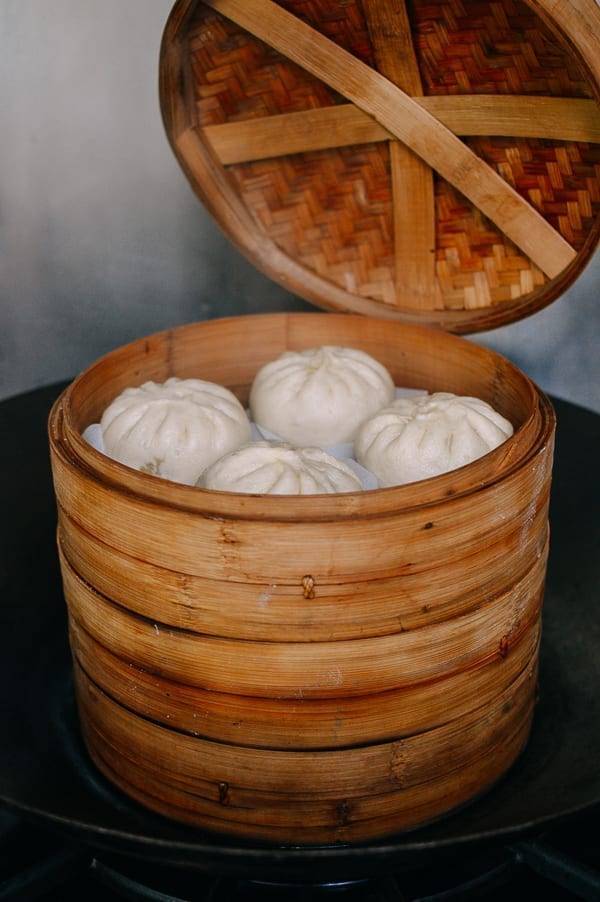
To store (if you have any leftovers):
Once the steamed pork buns are cooled completely, pack them in an airtight container. They can be refrigerated or frozen.
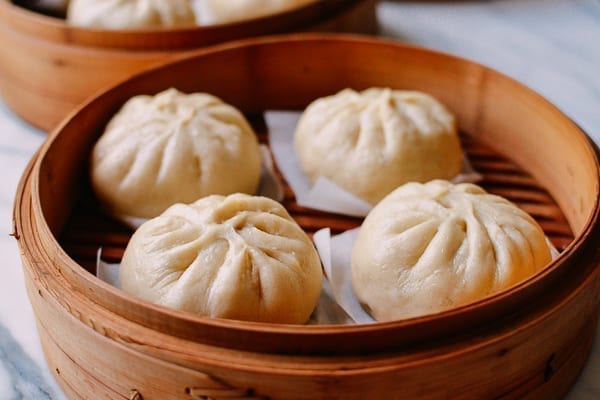
Of course, steamed pork buns are best eaten fresh!
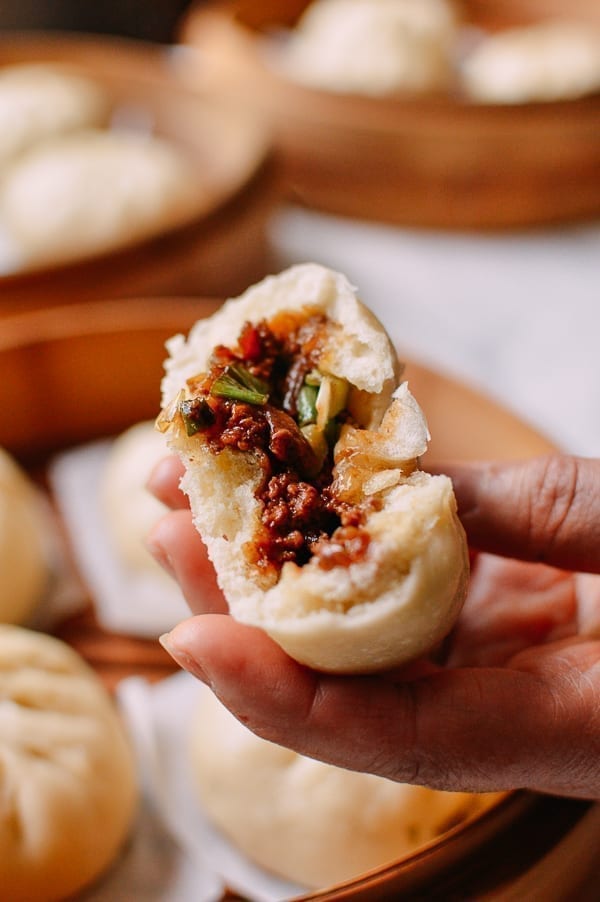
To reheat:
Out of the refrigerator, simply microwave the buns for 1-2 minutes. Alternatively, re-steam them for 5 minutes. If reheating frozen buns, there’s no need to thaw beforehand. Simply steam them for 8 minutes.
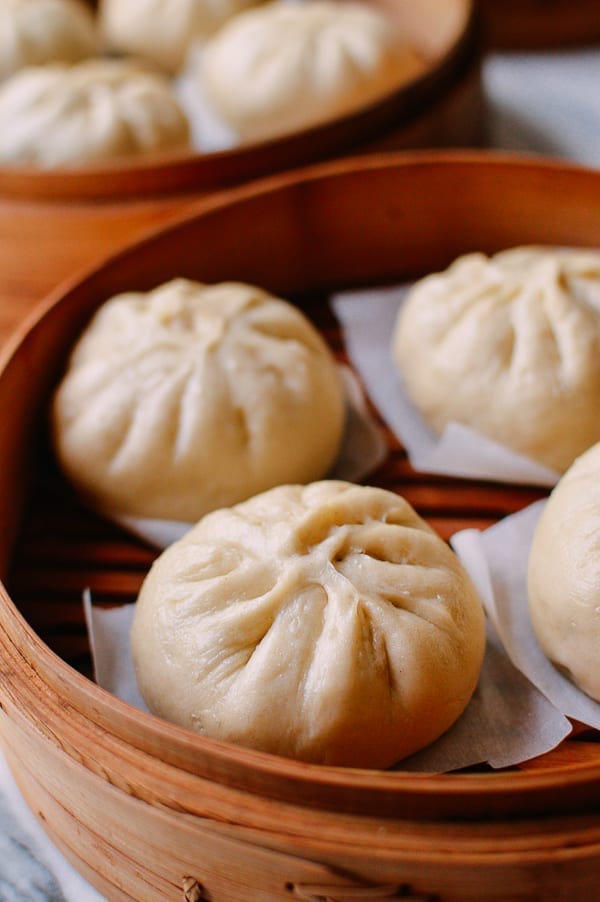
Steamed Pork Buns (Baozi)
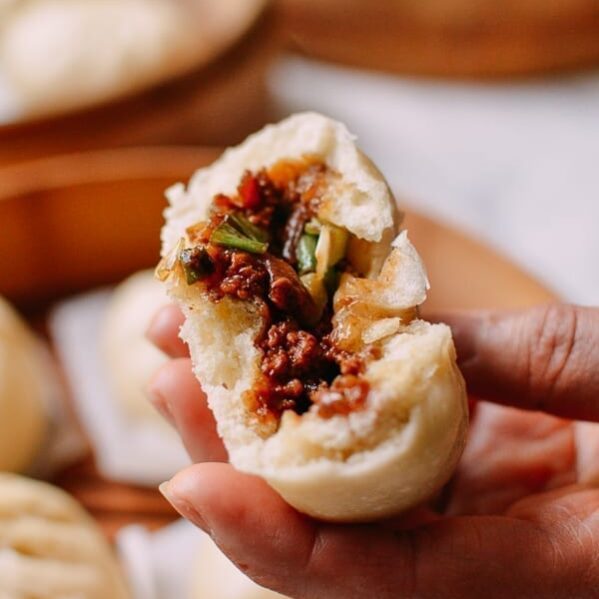
Ingredients
For the dough:
- 5 g active dry yeast (about 1 1/2 teaspoons, or more precisely, 1.6 teaspoons; best to use weight measurements)
- 8 g granulated sugar (2 teaspoons)
- 1 1/2 cups lukewarm water (355 ml)
- 580 g all purpose flour (about 5 cups, plus extra for kneading and rolling)
For the filling:
- 700 g ground pork (1 1/2 pounds; can substitute ground chicken or beef)
- 3 tablespoons water (45 ml)
- 3 tablespoons vegetable oil (45 ml)
- 2 tablespoons ginger (about 20g, minced)
- 1 large onion (about 200g, minced)
- 2 tablespoons Shaoxing wine (30 ml, can substitute any other Chinese rice wine or dry cooking sherry)
- 1 tablespoon dark soy sauce (15 ml)
- 1 tablespoon sweet bean sauce (甜面酱; can substitute hoisin sauce)
- 2 tablespoons ground bean sauce
- 1 tablespoon oyster sauce
- 1 teaspoon sugar (4g)
- 1/2 teaspoon white pepper
- 2 teaspoons sesame oil
- 1 1/2 teaspoons cornstarch (mixed with 1 tablespoon water)
- 3 scallions (finely chopped)
Instructions
To make the dough:
- In a large mixing bowl or mixer with a dough hook attachment, completely dissolve yeast and sugar in lukewarm water. Wait 10-15 minutes to let the yeast become active and foam up.
- Add in the flour ½ cup at a time and knead for about 15 minutes. Adjust the last ½ cup flour accordingly. The dough should be soft––not sticky and not too firm. Once the dough is even and smooth, form it into a ball. Cover it with a damp kitchen towel and let it proof one hour in a warm place. (If kneading by hand, knead the dough until it’s as smooth as a baby’s butt!) While it’s proofing, make the filling.
To make the filling:
- Add the ground meat to a large mixing bowl and stir in 3 tablespoons water until well incorporated.
- Now preheat the wok or a cast iron pan until it starts to smoke lightly. Add in 3 tablespoons oil, along with the minced ginger and diced onion. Cook over medium heat until the onions soften. Add in the ground pork and turn up the heat, stirring to break up any large chunks. Cook until all the pork turns pale and opaque––there is no need to brown or crisp the meat.
- Add wine, dark soy sauce, sweet bean sauce, ground bean sauce, oyster sauce, sugar, white pepper, and sesame oil. With the heat on high, stir everything together until well-combined. Taste the filling and adjust seasoning if needed.
- Cook for a couple of more minutes to cook off any remaining liquid. Stir in the cornstarch and water mixture, allowing everything to bubble together for 30 seconds to a minute. Turn off the heat and let the filling cool uncovered. After the filling has cooled, mix in the chopped scallions.
To assemble the baozi (buns):
- After the dough has finished proofing, turn it out onto a clean surface dusted with flour. Knead for 2 minutes to get rid of any air pockets. Weigh and divide the dough into 20 equal pieces (each should weigh about 48g-50g).
- Take each dough ball, and with a rolling pin, roll it from the edge towards the center, without actually rolling the center of the dough. The goal is to flatten the dough into a round circle with a thinner edge and thicker center. The difference in thickness should be about 1:2. Add some filling to the center.
- You can start with a smaller amount of filling until you get the hang of the folding/pleating. The buns are folded with one hand holding the skin and filling, and the other hand pleating the edges of the dough disk like an accordion. As you fold, the goal is to make it all the way around the circle, until you’ve sealed it at the top. You’ll be making about 10-15 folds. Lay the buns on a small piece of parchment paper and put it directly on your steaming rack. Repeat until all are assembled. Let the buns proof (covered) for another 15 minutes before steaming.
- If you’d rather not pleat the buns at all, simply pinch the edges of dough around the filling and pinch to seal tightly. Then simply flip the buns seam side down, cover, and proof for 15 minutes.
To steam:
- With the buns in the steamer, start with cold water and turn on the heat to medium. Set the timer to 15 minutes.
- After 15 minutes, turn off the heat, and keep the lid on. Let the buns “rest” for 5 minutes before opening the lid. Missing this step will cause the buns to collapse.
To store leftovers and reheat:
- Once the buns are steamed and cooled completely, pack them in an airtight container. They can be refrigerated or frozen.
- Out of the refrigerator, simply microwave the buns for 1-2 minutes. Alternatively, re-steam them for 5 minutes. If re-heating frozen buns, there’s no need to thaw beforehand. Simply steam them for 8 minutes.
